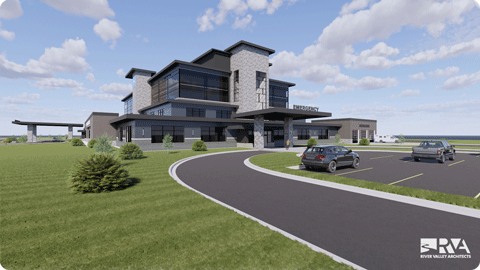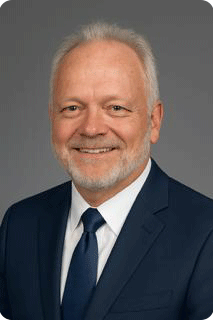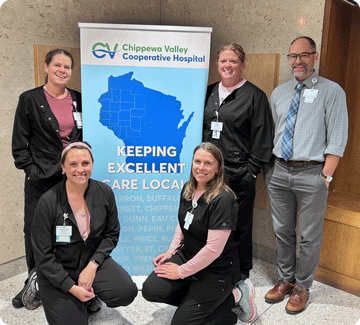A healthier outlook for Chippewa Valley
New health cooperative will deliver local, member-driven health care to 18 counties in Northern Wisconsin
In 2024, two hospitals, a cancer clinic, and 19 Prevea clinics closed unexpectedly in Eau Claire and Chippewa Falls, leaving more than 70,000 people scrambling for local health care.
Women in labor were diverted to hospitals hours away. Patients waited days in emergency rooms for critical surgeries, like heart shunt procedures. More than 300 patients lost convenient access to cancer treatments.

Artist rendering of new Chippewa Valley Health Cooperative hospital.
It was a tremendous loss. St. Joseph’s and Sacred Heart Hospitals had served these communities for more than 100 years.
In response to this crisis, a small group of local community leaders and doctors stepped up to create a solution by the people, and for the people, of the Chippewa Valley region called the Chippewa Valley Health Cooperative (CVHC)— a nonprofit organization governed by local citizens that aims to build a 48-bed, $158 million hospital slated to open in early 2028 in Lake Hallie, a strategic location between Eau Claire and Chippewa Falls.
“We are returning control of our health care to our community. Health care decisions and investments will be made in our community by a local governing board, not by executives in a distant corporate boardroom,” explains Mickey Judkins, a small business owner and member of the CVHC board of directors.

Mike Sanders, Chief Executive Officer
The good news has spread. Within days of posting about the new hospital, more than 400 people went to the CVHC website to express their interest in employment opportunities.
What’s more, more than 100 doctors who practiced for decades at St. Joseph’s and Sacred Heart have pledged to work at the new hospital. “The biggest win so far has been the tremendous commitment from community leaders and physicians to come together and make this cooperative happen,” says Mike Sanders, CVHC, Chief Executive Officer.
The concept of a member-driven health cooperative, adds Sanders, was born from the idea that when decisions are made locally from within a community and layers of corporate bureaucracy are removed, hospitals and clinics can deliver more responsive care to patients.
Bridging the gap with an interim hospital
While the new hospital is being built, CVHC will reopen the former St. Joseph’s Hospital as an interim solution to bridge the gap in care. The interim hospital, named Chippewa Valley Cooperative Hospital, planned to open three outpatient clinics in late 2025 for advanced wound care, chemotherapy, and infusion services to treat patients with the most immediate needs.
 The biggest challenge is setting up the hospital’s electronic records system, which takes up to a year to implement. Once in place, Chippewa Valley Cooperative Hospital will be able to expand its health care services to include labor and delivery, an emergency room, critical care, surgery, a full cancer center, and advanced diagnostics.
The biggest challenge is setting up the hospital’s electronic records system, which takes up to a year to implement. Once in place, Chippewa Valley Cooperative Hospital will be able to expand its health care services to include labor and delivery, an emergency room, critical care, surgery, a full cancer center, and advanced diagnostics.
To date, more than $13 million has been raised for the interim hospital. “The new equipment, beds, and technology we buy for the temporary facility will go with us to the new hospital,” says Sanders.
Backed by state support
A $50,000 Cooperative Development Grant from WEDC covered the legal costs of creating a cooperative, establishing bylaws, and setting up the governance structure.
“When you are forming a new entity as complex as a cooperative, legal services are a significant cost and can be a burden on future members. This grant helped reduce the barrier of entry for the Chippewa Valley Health Cooperative,” says WEDC Regional Economic Development Director Ray French.
“In rural Wisconsin, cooperatives aren’t just businesses—they’re community builders,” adds WEDC Rural Initiatives Manager Kietra Olson. “They keep wealth local, empower community members, and ensure that progress is shared by everyone.”


